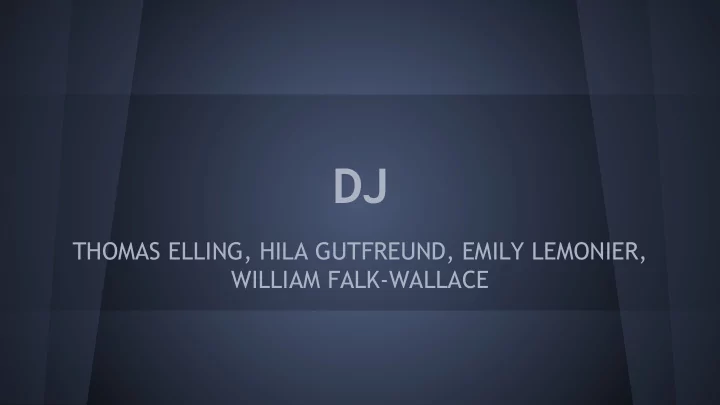

DJ THOMAS ELLING, HILA GUTFREUND, EMILY LEMONIER, WILLIAM FALK-WALLACE
Why a music language? ● Music lends itself to programming ● Interesting field to explore ● Allows for the use of Java libraries ● Combines artistry with computer science
Intro to DJ ● DJ abstracts the difficulties of MIDI programming ● DJ makes music programming intuitive ● DJ Focuses on Conventions and Simplified Programming ● DJ enables serial and parallel addition to extend chords and tracks
Language tutorial: 1. JMusic 2. Data Types & Hello World 3. Programmatic Structure 4. Control Flow 5. Functionality 6. Example: Hello World
JMusic ● Music library for Java ● Abstracts difficult midi music composition ● Allows for the creation of notes, chords, tracks, and scores. ● Built in instrument library including: flute, piano, guitar, xylophone, etc. http://explodingart.com/jmusic/
DJ: Data Types song score ( ) { double double pitchA = 141.32; note double volume = 100; double duration = 2; chord double piano = 0; note n = note (pitchA, volume, duration); track chord c = chord ( n ); track t = track ( 0 ); score t = t.c; score s = score( t ); return s; }
DJ: Programmatic Structure double C4 = 261.63; Main function: song score () { song score () { … } double pitchA = C4; double volume = 100; Global Variables double duration = 5; note n; Inline initialization n = note (pitchA, volume, duration); track t = track (5); score s = score( t ); return s; }
DJ: Control Flow song score ( ) { For double i; If/Else for (i = 0 ; i < 5 ; i = i + 1) {...} While loop (5) {...} score s = score(); Loop return s; }
createOtherNote note (note n) { DJ: Functionality /* creates + returns new note*/ double p = n -> pitch + 40; double v = n -> vol + 10; double d = n -> dur + 5; ● Serial Add . return note(p, v, d); ● Parallel Add : } ● Note Attribute song score () { note n1 = note(440, 100, 5); Accessor -> note n2 = createOtherNote(n1); note n3 = createOtherNote(n2); chord c = chord(n1); c = c:n2; c = c:n3; track t = track(26); t = t.c; score s = score(t); return s; }
song score () Example: HelloWorld { double pitchA; double volume; double duration; Making Noise! pitchA = 440; volume=50; duration=4; note n = note (pitchA, volume, duration); chord c = chord(n); track t = track( 0 ); t = t . c; score s = score(t); return s; }
Implementation: 1. Process 2. Structure 3. Statistics
Implementation Process: semcheck
Implementation Process: Javagen
Implementation Process: More Javagen
Structure of DJ Java Compile Input File AST Semcheck Java Code Utility (compile.sh) Java Scanner SAST Generation Midi File Parser (compile.ml)
Statistics ● 540 Commits to Master ● 25 Feature Branches ● 30 Issues and Pull Requests Assigned
Lessons Learned ● Do your research into any extra libraries you’ll need ● Everyone should be tangentially involved in every step of the way ● Don’t shy away from trying a hard language ● To fully create a language, you are going to have to leave time to make it twice
The End All code can be found on our github repository at: http://whet-plt.github.io/wdjc/ Thank you!
Demo: Legend of Zelda!
Recommend
More recommend